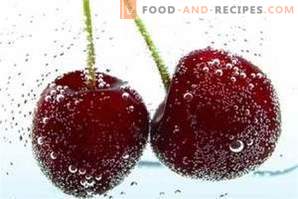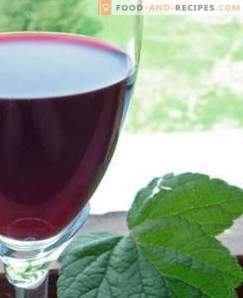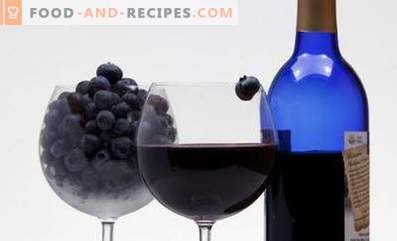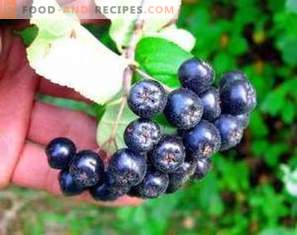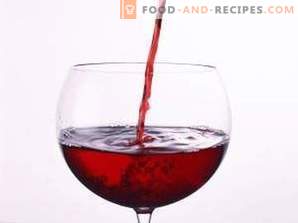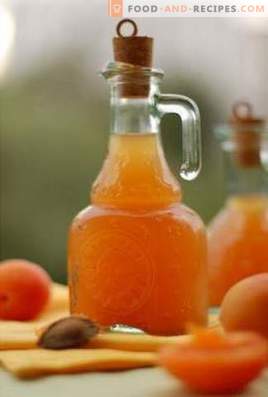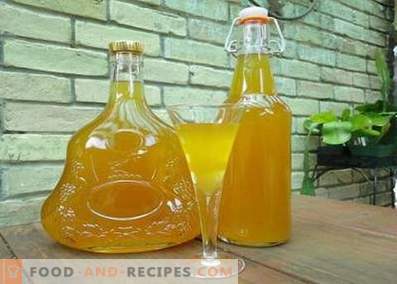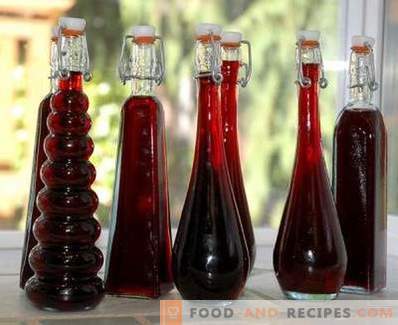
Mulberry fruits are watery, not too sweet and absolutely unsuitable for making jam. As a result, large berries, externally similar to blackberries, fall off and rot, without being in demand. Meanwhile, mulberry wine can be made at home, but some tricks will have to be taken into account, since otherwise the drink will turn out to be bland or will not work out at all.
The subtleties of the process
Cooking mulberry wine has its own characteristics that you need to know, otherwise the finished drink is unlikely to meet the expectations.
- Live bacteria live on the surface of the berries of a mulberry tree, so that theoretically fermented wort is possible without the addition of wine yeast. But in fact, without them, problems can arise. Therefore, the advice not to wash the berries can be neglected, but you need to stock up on wine yeast.
- When the berries have ripened and begin to fall, they should be collected without delay in the long box: the period when their collection is possible for further preparation of wine is small.
- White and black mulberries are the most common, and red is also found. The darker the color of the berry, the richer the color and aroma of the drink. However, dark varieties, like blueberries, paint the tongue and palate blue. It is impossible to neutralize this action of mulberry juice. If this moment is important for you, it is better to give preference to white mulberry, which will not create any pigmentation in your language.
- To give the wine a sour taste, it is recommended to blend it or use citric acid, lemon juice.
- It is often recommended to use pectin enzyme to increase the flow of hair and improve the consistency of the drink. He, like dry wine yeast, is sold in specialized stores. When using pectin enzyme, it is introduced into the wort 12 hours before the introduction of the yeast, after adding which fermentation begins.
- The fermentation of the wort may take two months or more. In this case, 50 days after the start of fermentation, the liquid must be drained, freeing it from the sediment, into a clean bottle and left for fermentation.
- After the almost finished wine is bottled, it will have to be poured into new ones every month, separating it from the sediment. At the same time, we must strive to minimize the contact of wine with oxygen.
The finished wine is stored for a rather long time - up to 4 years. The fortress has a small - 10-12 degrees, and the color - from pale pink to dark, it depends on the raw materials. The bouquet is due to the selected recipe.
Classic recipe from mulberry wine
Composition:
- mulberry berries - 3 kg;
- granulated sugar - 0.5 kg;
- raisins - 0.5 kg;
- pectin enzyme (desirable) - 5 g;
- wine yeast dry - 5 g;
- water - 2 l;
- citric acid - 10 g (can be replaced with juice from two lemons).
Cooking process:
- Cook the sugar syrup.
- Wash, reassemble the mulberry.
- Put the mulberry in a bowl with a wide neck, you can use the enameled basin, bucket. Sprinkle raisins on top and cover with hot syrup.
- After a couple of hours, add citric acid and pectin enzyme.
- After another 12 hours, put the yeast, stir.
- All this time and for the next 4 days, the mixture should be covered with a cloth to protect it from flies and be in a warm but not bright place. Stir it at least twice a day to prevent spillage.
- After the specified time, squeeze the juice out of the berries. It is more convenient to do this with a screw press, picking berries into a cloth or gauze.
- Put the juice in a clean bottle by placing a water seal on it. It can be replaced with a rubber or silicone glove with a punctured finger.
- Watch the behavior of the wort. Having waited for the end of fermentation, that is, the time when the glove will be deflated or the hydraulic lock will “shut up”, drain the liquid, leaving sediments at the bottom, filter and pour into clean bottles. The more fully they are filled, the better: contact with the air is useless. Close tightly.
- Place the bottles horizontally in a room with a low temperature. In the next four months, check to see if there is a lot of sediment. If its level exceeds 2 cm, pour out the wine, freeing it from sediment, and pour it into a new bottle. After 4 months, the wine can already be tasted.
Mulberry Spiced Wine
Composition:
- mulberry - 1 kg;
- granulated sugar - 1, 4 kg;
- purified or spring water - 3, 8 l;
- lemon juice - 100 ml;
- fresh or dried mint, chopped - 60 g fresh or 20 g dry;
- cinnamon - 2 sticks;
- wine yeast (pure culture) - 2, 5 g.
Preparation Method:
- Heat the water and dissolve the sugar in it. Syrup is considered ready when it becomes transparent.
- Remember mulberries and cover with syrup. Pour lemon juice there, add cinnamon, add mint. Cover with a napkin or thin towel. Put in a warm place.
- For one and a half days, stir the fermenting mass twice a day so that it does not turn sour.
- After 10 days, squeeze the juice out of the pulp by placing the berries in a thin fabric bag and using the press.
- Strain through cheesecloth and pour into a bottle with a water seal.
- When the fermentation is complete and the sediment has precipitated, pour out the wine, freeing it from the sediment, strain it again, bottle it and store it. You can try in 4 months.
Mulberry Wine “Honey”
Composition:
- mulberry (white) - 4 kg;
- rhubarb - 0, 4 kg;
- lemons - 3 pcs .;
- apple juice - 6 l;
- sugar - 1 kg;
- honey - 0, 4 kg;
- wine yeast - 5 g.
Preparation Method:
- Pick, rinse, crush the berries, place them in a basin or large enameled tank.
- Pour sugar on top, add honey.
- Skip the lemons through the meat grinder, without peeling, and put everything along with the juice and zest to the mulberry berries.
- Using a juice extractor, squeeze 6 liters of juice out of apples.
- Pour juice over the berries.
- Boil it all over low heat until sugar and honey are dissolved.
- Wait for the mixture to cool to room temperature (20-25 degrees), enter the yeast.
- Pour into a clean bucket, fix gauze on top, take the bucket to a warm room for 3 days. Stir 2-3 times daily to prevent mold.
- Squeeze the juice, strain, transfer to the fermentation tank, setting the water seal.
- Wait for the fermentation to end. It will happen in about a month and a half.
- Filter and pour into the fermentation bottle again. Install the water lock. Wait another month.
- Drain so that sediment remains in the bottle. This is done through a tube, one end of which is dipped into a container with wine, the other into an empty container, standing just below.
- Filter through gauze or cotton pad.
- Bottled, corked and placed horizontally in a room where the temperature is 16-18 degrees. After 3 months you can take a sample.
Cherry-Mulberry Wine
Composition:
- mulberry berries (dark) - 3, 6 kg;
- cherry juice - 0, 8 l;
- sugar - 2, 8 kg;
- lemon juice - 30 ml;
- wine yeast - 10 g.
Preparation Method:
- Wash, grab and crush mulberry trees.
- Add sugar, cherry and lemon juice to them. Heat, dissolve sugar, wait until it cools to 24 degrees.
- Add special wine-making yeast. Stir. Cover with a cloth, place in a warm corner protected from sunlight.
- Mix every 8-12 hours with a wooden stick.
- After three days, compress the berries to get the juice. Filter it through cheesecloth. Place in a fermentation vessel with a water seal.
- Wait until the fermentation is complete, strain it through cheesecloth, bottle it and seal it tightly.
- After three months, see how much sediment is in the bottles. If a lot, then strain the wine and pour into new bottles. Again, plug them well. Store in a cool place, placing the bottle horizontally. Fully prepared wine will be in six months.
Recipe with white wine
Composition:
- mulberries - 2 kg;
- granulated sugar - 1 kg;
- white table wine (semi-sweet grape) - 0, 75 l;
- ground cinnamon - 30 g;
- clean water - 5 l.
Preparation Method:
- Mash the unwashed berries and leave for a day.
- Squeeze the juice out of the berries by pressing.
- Add sugar and cinnamon to the juice. In an enamel container, for example in a bucket, leave to ferment, covering with gauze. The optimum temperature for fermentation is 23 degrees.
- Stir the billet twice a day.
- After 3 days, filter the juice, mix with water and pour into a fermentation tank. Pour in a bottle of wine. Install the water lock.
- When the gurgling stops completely, make a note on the calendar to empty the wine two weeks later, remove the sediment, filter and bottle.
- Cork a bottle of wine, after 3 months you can taste and treat guests with an unusual drink.
Mulberry is not the most suitable berry for culinary experiments; nevertheless, it can be made into a palatable wine with a delicate aroma. All that is needed for this is to study the details of the technological process and to strictly follow the chosen recipe.
